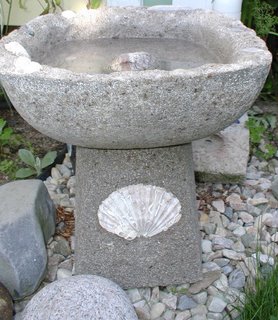 As the weather warms up, and the end of the school year approaches, when not thinking about gardening, I'm thinking about hypertufa. Hypertufa is a lightweight concrete made with peat moss. Over time, the moss breaks down leaving the hypertufa very porous and rustic looking. Supposedly the hypertufa was developed to mimic ancient watering troughs made from limestone called tufa, in use in Britain for centuries.
As the weather warms up, and the end of the school year approaches, when not thinking about gardening, I'm thinking about hypertufa. Hypertufa is a lightweight concrete made with peat moss. Over time, the moss breaks down leaving the hypertufa very porous and rustic looking. Supposedly the hypertufa was developed to mimic ancient watering troughs made from limestone called tufa, in use in Britain for centuries.Hypertufa, or tufa, as I call it, is a wonderful medium for making planters and bird baths, water fountains, sculpture, you name it. It’s made from Portland cement and aggregate materials, sand, perlite, vermiculite, etc., although to be proper hypertufa it must contain Portland cement and peat moss.
We’ve been making hypertufa things for a few years now, and have led a few workshops on hypertufa, I’ve even had my recipes (“borrowed” from my old website without credit) featured on a gardening show on cable tv.
 Tufa is amazing stuff, very forgiving and capable of very different looks based on the aggregate used. I like using molds to make tufa items, but it can be successfully hand formed or used to make sculpture. Last year we successfully made a faux hypertufa Japanese Lantern from a plastic garbage can, a plastic bowl, a juice bottle and a light fixture.
Tufa is amazing stuff, very forgiving and capable of very different looks based on the aggregate used. I like using molds to make tufa items, but it can be successfully hand formed or used to make sculpture. Last year we successfully made a faux hypertufa Japanese Lantern from a plastic garbage can, a plastic bowl, a juice bottle and a light fixture.
We’ve even branched out into straight concrete items, making concrete birdbaths, planters and pedestals using some terrific molds available from History Stones.
With work and chickens and garden I’ve been too busy to think much about tufa, but now that the weather is warm enough (tufa needs temperatures above 50º F while curing) I’m starting to feel the creative juices flowing, and I am thinking about trying to replicate a standing stone I saw on the Scottish Isle of Raasay a few years ago, carved by the ancient Picts. Now wouldn’t that look cool in the garden….

1 comment:
Hallo I absolutely adore your site. You have beautiful graphics I have ever seen.
»
Post a Comment